Original link: https://shyrz.me/news-18-futurism/

22·07·24 Issue No. 18

Ladies and gentlemen, the epidemic situation is repeated and the heat is scorching hot, please take care. Thanks for the support of the friends who gave the prize in the last issue.
In this selection of articles, Is Bionic Reading Really Effective? “From the control experiment of Bionic Reading by the Readwise team, it is not shy to question its existence; “Who is afraid of TikTok?” ” and further reading “TikTok is growing, and governments’ vigilance against it is also growing” exposes the darkness hidden under TikTok’s brutal expansion and glossy appearance, as well as the complex attitudes of various governments revealed by various considerations; “On << The Futurist Manifesto “Everything You Must Know” presents some anecdotes about the 20th century’s most influential futurist avant-garde movement that spanned painting, theatre, music, and even cooking.
Hope that inspires.
Does Bionic Reading Really Work?
Readwise Blog July 19, 2022 Author Daniel Doyon describes his team’s experiments with the popular Bionic Reading.
In June 2022, we published an experiment on Hacker News, Reddit, and Twitter to test the claim that bionic reading could allow people to read faster without compromising comprehension. Part 1 of this series provided an in-depth description of motivations, claims, and experimental designs. In this part 2, we’ll jump right into the results.
preparatory work
Participants were asked to read two 1000-word texts cut in half, forming the sections shown in Figures 1A, 1B, 2A, and 2B. The first font was randomly chosen for each tester (Literata plain or Literata with Bionic Reading applied) and then alternated.
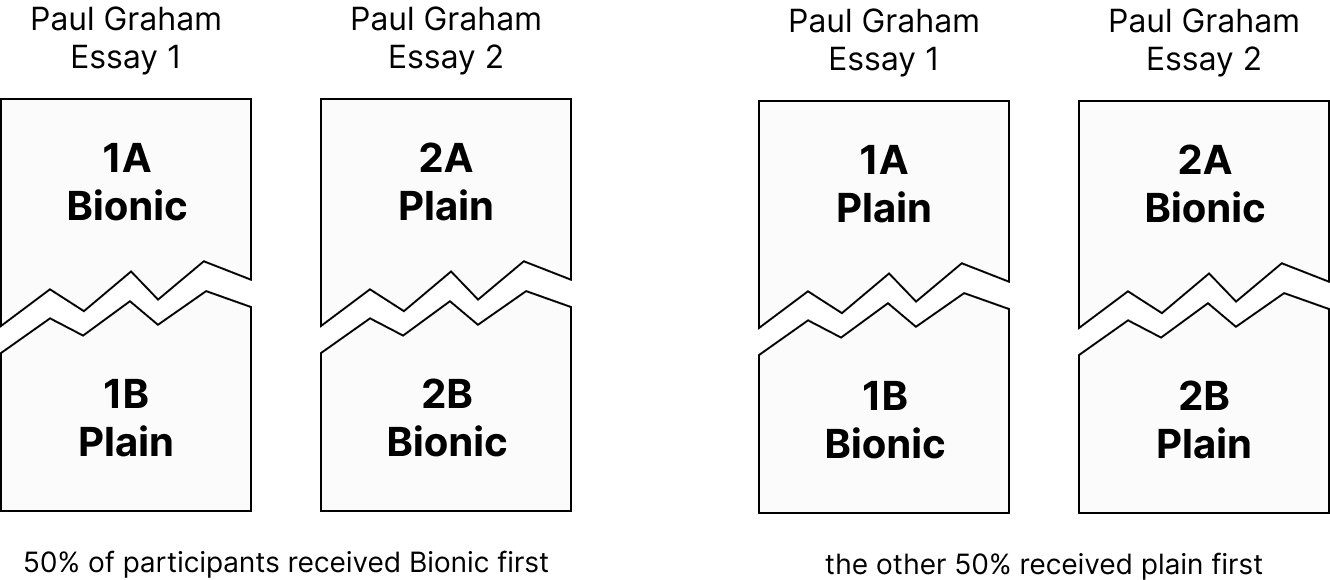
Selected articles were written by the same author (Paul Graham) during the same period (circa 2010) to minimize differences between articles. The matrix setup described above is designed to further control for inter-article variation (article 1 may be more readable or more interesting than article 2 and vice versa) and intra-article variation (the beginning of each article may be more readable or more readable than the end of each article). interesting, and vice versa).
When the cross-matrix reading speed for each font is averaged, we have a pair of reading speeds that are fairly comparable to each other, isolating the font as the independent variable. We also asked three multiple-choice questions at the end of each essay to control for reading comprehension.
data preparation
As with anything on the internet, completion rates follow a predictable funnel pattern. 3334 participants completed 1A, and the sample was gradually reduced to 2074 participants who completed all four items.
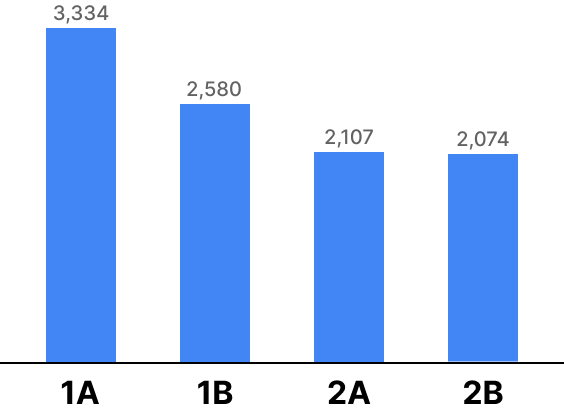
Some advanced statistical techniques, such as random-effects models, can take advantage of all data, whether or not each participant has completed all four halves. But for ease of interpretation, we decided to ignore any incomplete entries, resulting in an initial sample size of n=2074—still sufficient to support a robust statistical analysis.
As with anything on the internet, there is some junk data that must be removed.
- First, we removed any multiple entries (37 entries) from the same IP address.
- Next, we removed the entry called “tirekickers”—those who, like curious cats, clicked to start an experiment but quickly swiped to the bottom, then clicked next to see what happened. We can identify these participants by reading speeds that are impossible for humans, eg 2 seconds to read 500 words. To achieve our goal, we used a cutoff of 2000 words per minute (95 entries).
- Finally, we removed entries called “quitters”—participants who started in earnest but gave up near the end and quickly scrolled to the bottom to see the results. To achieve our goal, we could identify these participants by their reading speed on 2A or 2B being 2x higher than their previous average reading speed (20 items) on 1A, 1B, and 2A, respectively.
This data preparation resulted in the final dataset n=1916.
We understand that outlier removal is a delicate process that may introduce bias into the dataset, but based on observations of participants and our expertise, we are confident that these entries are invalid.
Average speed per font
As mentioned above, we can now average each participant’s results for each font to arrive at a pair of comparable speeds. Let’s quickly explore a summary of the speed statistics for each font.
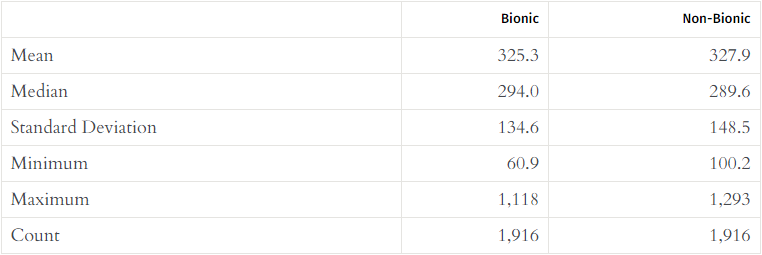 Table 1: Aggregated Speed Statistics (WPM) for Each Font
Table 1: Aggregated Speed Statistics (WPM) for Each Font
As you can see above, the average speeds of the two fonts (325.3 and 327.9 words/min, respectively) are nearly identical, with non-bionic reading actually being about 3 words per minute faster. In percentage terms, however, this is a paltry 0.8% difference.
Average speed difference per participant
The benefit of this experiment is that we can perform a variety of “paired” analyses that not only control for changes in reading speed across articles and article positions, but also across individuals. On average, the observed differences should be due to fonts rather than other underlying factors.
The easiest way to see the difference is to subtract each participant’s non-bionic reading speed from their bionic reading speed. If bionic reading could help people read faster, we would expect to see an average difference greater than 0 words per minute.
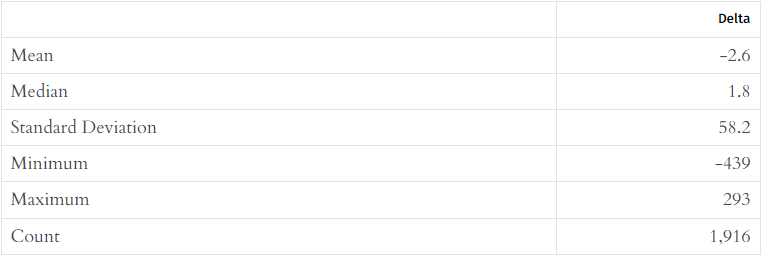 Table 2: Aggregated Speed Difference Statistics (WPM) per User
Table 2: Aggregated Speed Difference Statistics (WPM) per User
In short, the opposite was true: In our sample, participants who used Bionic Reading were on average 2.6 words per minute slower than those who did not.
Average speed difference for each faster font
Since posting this experiment, I’ve gotten a lot of onlooker comments along the lines of: “Well, I certainly don’t expect bionic reading to work for most people, but for people like me, it does.” If If so, we might expect to see a disproportionate improvement in those participants who read faster with bionic reading than those who did not. Let’s take a look at how many participants read faster with each font, and their average speed improvement.
 Table 3: Aggregated speed differences for each faster font
Table 3: Aggregated speed differences for each faster font
The number of people who read faster with Bionic Reading (52%) was slightly higher than those who did not (48%). That is, those who used the bionic to read faster were only able to read an average of 35 words per minute. In contrast, those who didn’t read bionics read faster, at 43 words per minute. Bionic reading doesn’t seem to really work.
hypothetical test
Now let’s run a paired t-test to test the null hypothesis that the average speed of reading with bionic is equal to the average speed of reading without bionic.
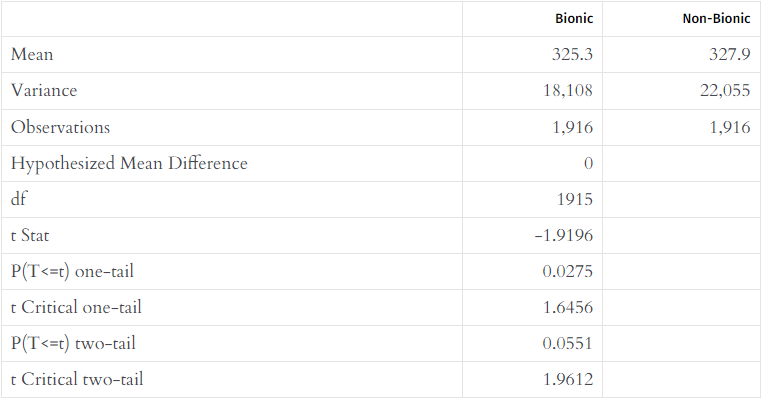 Table 4: Paired two-sample t-test results
Table 4: Paired two-sample t-test results
Statistically, the mean speed difference (M = -2.6, SD = 58.2, N = 1916) was not significantly different from 0 (t = -1.92, two-tailed p-value = 0.055), which means that we cannot reject the null hypothesis. The 95% confidence interval for the difference in mean speed was [0.1, -5.2], almost implying that bionic reading actually had a negative effect on reading speed.
Simply put, we almost got a statistically significant result that the bionic reading is slower. However, as mentioned in the introduction, we’re talking about such small magnitudes here (less than 1% difference) that you might conclude that bionic reading has no effect at all.
understand
So far, we’ve been testing reading speed without regard to reading comprehension. Let’s quickly explore summary comprehension statistics for each font.
 Table 5: Summary comprehension statistics for each font (percent correct)
Table 5: Summary comprehension statistics for each font (percent correct)
As with reading speed, comprehension is almost the same for different fonts. In fact, the comprehension numbers are so close that I fear I’ve made a mistake. That said, I double-checked the calculations and they are correct.
These results are in line with common sense, and existing research shows that reading comprehension is inversely proportional to reading speed. The faster you read, the less you remember, and the slower you read, the more you remember. Because the reading speed of the two fonts was nearly the same in this experiment, we expected to see similar comprehension, which matched the facts.
in conclusion
Based on the data collected, it is difficult to find any evidence that bionic reading has any effect on reading speed or reading comprehension. Rather, our results appear to confirm previous research that there is no universal best font, but that particular configurations may lead to gains at the individual level.
For more on this, see Using Fonts to Accelerate Adult Reading: A Study of Personal Preference and Effectiveness and Towards a Personalized Reading Experience: Different Fonts Improve Reading Speed for Different Individuals (both by researchers at Adobe).
Based on the above, you might be thinking. So, as long as some people like it, who cares if Bionic Reading actually lives up to its claims? Who cares if it might just be a placebo? It’s just one more font. Give them what they want!
One thing that may not be obvious is that despite my casual use of the word “font” here, Bionic Read is definitely not another font that can be simply licensed and installed. Instead, it’s more of a font style that requires making an API call to the patent holder (and paying them a licensing fee) and then injecting various labels into your markup.
To give you an idea of what this looks like, here’s the first sentence of Paul Graham’s article on Applied Bionics Reading:
<p><b class="b bionic">Th</b>e <b class="b bionic">bes</b>t <b class="b bionic">wa</b>y <b class="b bionic">t</b>o <b class="b bionic">com</b>e <b class="b bionic">u</b>p <b class="b bionic">wit</b>h <b class="b bionic">start</b>up <b class="b bionic">ide</b>as <b class="b bionic">i</b>s <b class="b bionic">t</b>o <b class="b bionic">as</b>k <b class="b bionic">yourse</b>lf <b class="b bionic">th</b>e <b class="b bionic">questi</b>on: <b class="b bionic">wha</b>t <b class="b bionic">d</b>o <b class="b bionic">yo</b>u <b class="b bionic">wis</b>h <b class="b bionic">someo</b>ne <b class="b bionic">wou</b>ld <b class="b bionic">mak</b>e <b class="b bionic">fo</b>r <b class="b bionic">yo</b>u?</p>
And this is not applied:
<p>The best way to come up with startup ideas is to ask yourself the question: what do you wish someone would make for you?</p>
Is this a deal breaker as a software developer? of course not. But it’s really cumbersome, especially when building offline applications, so we’d prefer to have some proof that it’s worth it before introducing all this cost and complexity.
Another thing that may not be obvious – despite the skepticism that may be in these blog posts – is that we sincerely hope that Bionic Reading will prove to be effective. We do reading technology after all, and we truly believe that software has the potential to revolutionize the practice of reading. We’re looking for whatever advantages digital reading might offer to convince people to switch from paper to pixels. That’s our mission and why we built reading software in the first place.
For this reason, and because we had a lot of fun designing and executing this bionic reading experiment, we intend to conduct more testing in the hope of discovering a screen-reading technology that can yield material benefits. We know of some other technologies that look interesting, including BeeLine Reader, Spritz, and Sans Forgetica.
Is there something we overlooked? Let us know on Twitter or Hacker News !
Otherwise, stay tuned for our next reading speed experiment ?.
Who is afraid of TikTok?
The Economist, July 22, 2022.
With its wholesome dance and lip-syncing videos, TikTok once billed itself as “the last sunny corner of the internet.” Since its launch five years ago, the app has brought a warm glow to its more than 1 billion users, while also bringing icy competition to Silicon Valley’s social media giant. With its rise, a part of the tech industry that otherwise seemed to be far from competition was completely opened up. But while TikTok has delighted consumers and advertisers, others see a dark side to the sunny app. As TikTok’s influence grows and the U.S. election looms, a bipartisan storm is brewing in Congress as it is considered a “Trojan horse.”
The hype around TikTok is justified, and so are the concerns. This app has changed the competitive landscape of social media. Finding a way for TikTok to operate safely in the West is a test of whether global commerce and the global internet can remain intact as U.S.-China relations deteriorate.
Underneath TikTok’s simple interface lies a horribly advanced artificial intelligence (AI). TikTok’s knack for understanding people’s likes and dislikes helped TikTok sign up its first billion users in half the time it took Facebook. In the US, the average user spends 50% more time on the app each day than the average user on Instagram. TikTok’s revenue is expected to reach $12 billion this year and $23 billion in 2024, on par with YouTube. Young creators and some older creators are flocking to the app. This week, The Economist joined TikTok (we promise not to dance).
→ Further reading: TikTok is growing, and governments are growing wary of it / Geek Park
Everything you need to know about The Futurist Manifesto
 Umberto Boccioni, The Charge of the Pikes, 1916 / Wikimedia Commons (Public Domain)
Umberto Boccioni, The Charge of the Pikes, 1916 / Wikimedia Commons (Public Domain)
Futurism was one of the avant-garde movements of the 20th century that made its mark on modern art. The center of interest in the futuristic is the modern industrial city with all its new features such as speed, technology, youth and violence. They often painted new inventions, such as cars or airplanes, and also conceived their own manifesto, the Futurist Manifesto.
Futurism is mainly a work by Felipe Tommaso Marinetti, Umberto Boccioni, Carlo Carra, Gino Severini, Giacomo Barra and Antonio Santa Elia Conceived Italian phenomenon. There were parallel movements in countries such as Russia, the United Kingdom and Belgium during the same period.
Here’s everything you must know about The Futurist Manifesto:
It was written by… a poet

Filippo Tommaso Marinetti was not an artist – he was a poet. He wrote the Futurist Manifesto in 1908, which appeared for the first time as a preface to his collection of poems, published in Milan in January 1909. It was published in the Italian newspaper Gazzetta dell’Emilia in Bologna on February 5 of the same year, followed by the French version Manifeste du futurisme in the newspaper Le Figaro on February 20.
Futurists fight the past

For the futurists, 19th-century Italy was synonymous with all horrors. They want Italy to keep up with the growing importance of industry, to be able to participate in new experiences and to find the superior essence of progress in its main hallmark: the car and its speed.
Futurists want literature to keep up with the times

Futurists want literature to be part of progress. They want literature to adapt to it, to be a tool to embody it.
they like speed

People are responding to the potentially overwhelming force of progress and shouting about their centrality. People will use speed, not the other way around. — The Futurist Manifesto, Articles 5 and 6.
For them, poetry is associated with aggression

In the Futurist Manifesto, poetry is seen as a tool to help people submit their souls and become part of a new reality (Articles 6, 7), indicating a new aesthetic concept that will refer to the human instinct of aggression .
They demand purification by war

In the Manifesto, war is dangerously defined as something necessary for human mental health, a purification that allows and favors idealism. Their explicit praise for war and its “hygienic” character influenced the ideology of fascism. For example, the Futurists were part of the Fascist Fighting Group before it took power. Marinetti was active in fascist politics until he quit.
They want to… burn down the museum!

We’re going to tear down museums and libraries, and fight morality, feminism, and all the cowardice of opportunism, utilitarianism – The Futurist Manifesto, Art, Article 10
The Manifesto makes little mention of art itself

The founding manifesto did not contain an active artistic programme, which the Futurists attempted to create in the subsequent Manifesto of the Technique of Futuristic Painting (1914). This led them to work on a “universal dynamic” that would be directly reflected in the painting.
Quick Facts
- ? Design: The Business Power of Design: Understanding Airbnb’s Redesign
- ? Design: Good Web Design: Examples of Delightful Data Visualizations
- ⌛ Efficiency: I have used all notebooks
- ⌛ Art: Modern Art and Respect for Machines
- ? The economy: what are diminishing returns and how to prevent them
donate
?Shyrism.News is a selected newsletter, bi-weekly, covering new anecdotes, hot topics, cutting-edge technology and other things about life and the future. With careful and meticulous screening, we fight against the algorithm that is strong outside and in the middle, and neutralize the indifferent and rigid code with enthusiastic words.
If you find “Shyrism.News” valuable, please support and share it with your friends or social networks.
Thank you friends for tipping, please be sure to note your salutation or email address to avoid losing data when you clean up your account.
This article is reprinted from: https://shyrz.me/news-18-futurism/
This site is for inclusion only, and the copyright belongs to the original author.

